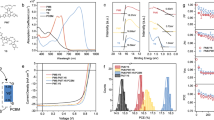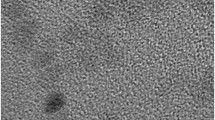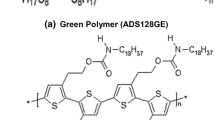Abstract
The organic materials presented here, e.g. cyano-ether-PPV, different bisarylamidine-perylenes and conventional as well as substituted forms of phthalocyanines exhibit the advantages of low processing costs and the simplicity of tuning their optical properties. Hence they are promising candidates to be used in large area photovoltaic applications. The investigated cells consist of one or two organic layers sandwiched between electrodes of indium tin oxide (ITO) and aluminum. The experimental techniques of electroabsorption(EA)- spectroscopy, photocurrent-action spectroscopy and current voltage characterization were used to gain further insight into the process of charge generation, charge separation and transport of the charged species to the electrodes. To enhance the quantum efficiencies of the photovoltaic cells, combinations of organic materials with electron-accepting and electron- donating properties in multilayer devices were investigated. We chose the organic materials copper-phthalocyanine and a bisarylamidineperylene whose HOMO and LUMO level alignment should favor a charge transfer process in order to increase the photocurrent(PC) responsivity by enhanced exciton dissociation. Additionally, one of the two layers of a double layer device was blended with small amounts of the material constituting the second layer to further increase charge carrier generation by extending the dissociation zone.
Similar content being viewed by others
References
M. Willander, A. Assadi and C. Svensson, Synth. Met., 57, 4099, (1993)
A.C. Patridge, P. Harris, and M.K. Andrews, Analyst., 121, 1349, (1996)
G. Yu and A.J. Heeger, Synth. Met., 85, 1183, (1987)
R.H. Friend et al., Solid State Commun., 102, 249, (1997)
C. W. Tang and A.C. Albrecht, J. Chem. Phys., 62, 2139, (1975)
F.H. Moser et al. “tThe Phthalocyanines”, VolII, CRC Press, Inc., Boca Raton 1983
D. Hohnholz, S. Steinbacher, M. Hanack, J. Mol. Struct., in press
H. Tillmann and H.H. Hörhold, Synth. Met., 101, 138–139, (1999)
Bayer, Baytron P Produkt Information, 01/1997
O. Inganaes et al., Polymer, 35, 1347, (1994)
T.M. Brown et al., Appl. Phys. Lett., 75, 1679–1681, (1999)
P. Haisch et al., Adv. Mat., 9, 316, (1997)
H. Quante, Y. Geerts, and K. Müllen, Chem. Mater., 9, 495–500, (1997)
H. Quante, Ph.D. Thesis, (1995)
A.K. Ghosh et al., Journal of Applied Physics, 45, 230–236, (1974)
G. Meinhardt et al., SPIE Proceedings, 3623, 46–57, (1999)
H. Yoshida, Y. Tokura and T Koda, Chem. Phys., 109, 375, (1986)
I.H. Campbell, M.D. Joswick and I.D. Parker, Appl. Phys. Lett., 67, 3171, (1995)
Author information
Authors and Affiliations
Rights and permissions
About this article
Cite this article
Meinhardt, G., Moderegger, E., Schröder, R. et al. Photovoltaic Effect in Multilayer Organic Systems. MRS Online Proceedings Library 598, 92 (1999). https://doi.org/10.1557/PROC-598-BB9.2
Published:
DOI: https://doi.org/10.1557/PROC-598-BB9.2




